#bys 2007
Explore tagged Tumblr posts
Text

Vicki is HERE...
#backyard sports#backyard baseball#vicki kawaguchi#bys 2007 remake#greenjunipertree's shitty doodles
10 notes
·
View notes
Text
My favorite fan meet-up memories!
Leverage Con-Con (2010)
Going to the Leverage Con-Con in 2010 with @holdouttrout. If I remember, we kind of decided to do it on a bit of a whim, and it ended up being the only Con-con that ever happened and it was so great! We had an amazing time, including one panel where Jonathan Frakes just randomly showed up halfway through and it was hilarious, and watching Gina Bellman be completely overwhelmed by fandom in hopefully a not terrible way, and Christian Kane being totally old hat at it and being like, “look, this is nothing, you should experience other fandoms.” And that one time Trout and I were just trying to take the elevator somewhere and BAM there were Beth Riesgraf, Timothy Hutton, and Aldis Hoge RIGHT THERE, trying to get in the elevator as we were leaving and my brain only had one thought which was: TALL, because holy heck the three of them together is just very tall.
I always keep a little notebook on me, have for years and years, and I also keep them all. This gave me an excuse to dig back through them. I found that I’d written something about the Con-con!
Awesome, small size, new, everyone has never done this before, get really genuine response. In general, fans have been really well behaved. Love the random drive bys. Whatever panel is going on, another actor, producer runs in to ask questions from audience. Like Jonathan Frakes running through Gina and Beth’s panel. Jonathan Frakes doing an impression of Patrick Stewart being asked to do a six-episode arc on Leverage: “Cable?!”
The actors also got asked what the team would do in a zombie apocalypse (which had amused me at the time because I had already written The Chainsaw Job which was a Leverage zombie-apocafic. Poor Trout having to deal with my freak out over it.)
Parker as role model for young girls. Things Not To Do When Asking Panel Questions: Multipart Questions Preface with comment or 10-minute personal story Remind actor of previous stalking/bizarre behavior How much do I love that one of the guest stars, after their panel is sitting down in the crowd and listening to the presentation of “Page to the Screen”. Albert, John, Chris. Copenhagen!
(I have no recollection of what Copenhagen! meant any longer. Trout?)
DragonCon (2007)
Going to DragonCon in, wow I cannot for the life of me remember what year that was (must have been late naughty-aughts). I remember there was a great congregation of SG-1 peeps and @katcorvi and I shared a room despite never having met each other in person before and we shared endless jokes about which one of us was an axe murderer. Turns out neither, and we had a lovely time. We still exchange Christmas cards. I remember going to a Harry Potter panel with Pellucid to see the twins actors and people hissing about a book 7 spoiler despite it having been a long while since the last book came out. I am pretty sure this was also the time that we got to see Chris Judge learn what a furry is live on stage and it was all you can imagine. (Okay, that is what helped me figure out the year, because I found it on youtube! Also, was that shutthef_up who called out about fur suits? I feel like it was.) That was also the con where I came out of a stall in the bathroom and came face to face with Gates McFadden (who is also Very Tall or at least felt that way), which was very unexpected and made me freak out, especially after all those years of watching TNG and dreaming up self-insert fics where I fell in love with her TV son (not that I knew fanfic was a thing yet).
This was my first fangirl meetup and I was wildly nervous and probably very awkward and strange. But it was so great to meet people I had spent so much time with online. And it’s always funny to see how people do and don’t live up to the images you have of them in your head. (Like the most loquacious and thoughtful person who is nearly silence in-person.) I met so many people that it’s kind of a blur who was actually there. I think Abyssinia, Jennghis (Surreallis), Splash (were you there?), so many people.
London (2011)
Fangirl meet up in London (#2). In…oh boy. I am so bad at years. 2010? No, February 2011. I finally figured it out, primarily because I found notes I had taken in a notebook! We had a huge crew. Most of them were there for the Amanda Tapping con (AT5, I believe.) I was, for various reasons, too chicken to go to the con, even though I was literally in the con hotel for the first night of the convention. But Beanpot and I ran around together that night, if I recall. Before the con, we hung out in London. We ran around the British museum (which for Stargate SG-1 fangirls is even funnier that you would think, because we got to run around looking at the Egyptian stuff and make Goa’uld jokes). And someone…Trout? Was that us? We ran out to King’s Cross to find the little HP cart going into the wall thing they have, but the whole terminal was under construction. I remember not being able to sleep at night and it taking me days to realize it was because I was drinking English breakfast tea in the morning (I don’t do caffeine). We had a lot of cool pub hangouts too, and I remember something hilarious happening (of course) and me taking notes in a little notebook about it. Which I finally found by digging through 20 different little notebooks (which was fun. I think I found the first things I ever wrote about the idea of The Changeling in there too). My entry on the London meet up is pretty short. It just says:
Meet up. Hang out in Penn Club dining room. Walk to dinner at Turkish place. Walk to pub. Aspall’s cider. Very cool place Marquis Cornwallis. Good smut has no nouns.
London (2019)
London fangirl meet up #1, incidentally, was in 2008 when I was in London for not-fandom related reasons, and was lucky enough to meet up with @pepperf at the British museum. Again, I was weird and awkward and had never really hung out with a fandom friend in person much, and we had my non-fandom husband trailing around behind us. But it was still lovely, of course, and hanging out with Pepper is always the best. Which is why I am lucky I got London fangirl meet-up #3 in 2019, this time with Pepper and @bethanyactually. We did a lot of lovely things and had a great time, of which our peak fannish experience was running around London to find places BBC’s Strike had been filmed and getting to see Ibsen’s Rosmersholm on the West End, staring Hayley Atwell and Tom Burke. Can’t wait for London fangirl meetup #4.
That’s it, I think. I don’t think I’ve ever been to another Con.
9 notes
·
View notes
Text
I feel like I need to listen to ISTJ again, heh. If it's such a record breaker. Best-selling SM albums over the years.
So there are three interesting moments: 1) several big solo artists in the very begining (Kim Ming Jong was a CEO like Kangta and BoA, left with LSM in 2023; Jang Na Ra left long ago), 2) the 2003-2007 year jump, I guess it represents the rapid decline of album sales due to streaming platforms, which resulted in newer albums not selling well enough to enter the chart, 3) the increase in album sales in 2020, the change of fans' attitude towards bulk bying.
ISTJ will probably stay the record-holder. The covid is over, so the album sales have dropped some.

1 note
·
View note
Text

such as La Goulue and Jane Avril, were highly paid for their appearances at the Moulin Rouge and elsewhere. The female dancers of the French Second Empire and the fin de siecle developed the various cancan moves. The Galop from Jacques Offenbach's Orpheus in the Underworld is the tune most often played with the can-can (a somewhat simplified form and a more evolved one Can-Can (Orpheus in the Underworld). Performed on the accordion
Archived 2007-01-11 at the Wayback Machine).
The can-can was adapted as an American movie titled "Can Can"(1960), acted by Frank Sinatra and Shirley MacLaine with music by Cole Porter. Orpheus is a hero in Greek mythology.
When he played his lyre the world would sway to the music. It was noted he could charm mortals, Gods and even stones with his music. He was the son of a Muse. He was a companion of Jason and the Argonauts.
Orpheus was married to a dryad named
Eurydice. In one version of the myth, while trying to get away from a satyr Eurydice was bitten by a snake and went to Hades. Orpheus rode the ferry across the river Styx to bring her back from the underworld. He played his lyre to make Cerberus fall asleep, and moved the wife of Hades, Persephone, with his music. She said he could take Eurydice back to the upper world if he didn't look back at Eurydice until they both got back up to the land of mortals. Racked bys CLONES
1 note
·
View note
Text
Popular music is made by people who were not famous or rich before, just like you and me. They were discover in the streets, on TV shows, on YouTube etc etc

Justin Bieber, 2007, way before he became famous.
They are ordinary people with beautiful voices who just had the opportunity of a lifetime. Hence, in a certain way, we can identify to them. They try to put their feelings into music and it speaks to us. This gives to popular music a certain level of intimacy, privacy, people feel close to artists because they feel the same as them. It is like they put words on your emotions you just could not find.
Nevertheless, being this close to artists, people you actually do not really know personally, could be dangerous. As we know, there are some “problematic artists” : racists, misogynistics, homophobics, pedophiles and so on. Sometimes, it shows in their art.
Personally, I stopped listening to Beyoncé in 2016 when I discovered that her brand « Ivy Park » to empower women was made by women in clandestine workshops paid exactly $6.10 a day. Isn’t it ironic ?
Is it right to continue to listen to “problematic artists” ? Are we not somehow supporting their actions by listening to them via streaming services or by bying their music, giving them money and audience to speak to ?
10 notes
·
View notes
Text
bys where's the fanfic ab Matt n Gil celebrating Christmas that fixes Gilbert's 2007 Christmas experience





Where him and Matthew are walking hand in hand, he's like "I'm glad to be with you," and he's like "oh fuck I gotta spoil this man rotten" and he cries from joy
59 notes
·
View notes
Text
Practicalities and Mass shootings.
What if the REAL PROBLEM is the uniquely U.S. Culture rather than “crazy people”, video games or certain types of guns - all which exist in other Cultures?
If the above is correct, then political solutions will result in failure.
Consider...
The automatic weapon ban 1994-2004 did NOT appear to reduce mass shootings. The ban may have saved some lives by reducing the number of deaths per shooting. Deaths per mass shooting did increase after the ban.
The estimates are 8 million Armalite-type rifles in the US. Or 8M of 70M households (11% of household with fire arms)
Half of the US households have a firearm. - a significant voting bloc.
The last attempt at confiscation was April 18, 1775. It was dramatically unsuccessful.
Would the courts be convinced that a law was necessary when said law was challenged?
60% of gun deaths are suicides. This is an INCREASE since 1970
Murders are about 37% of gun deaths. 80% of murders are disputes between criminals. Rates of murders have decreased since 1970
The remaining 3% are accidents, justifiable homicide, etc have decreased.
As noted above the limited success of the 1994-2004 ban was, well, limited.
Is “Gun Legislation” politically a way to divide the country and insure votes for each party? A political football to be kicked up and down the field without ever scoring? So that nothing is accomplished.
What if the problem of gun violence is CULTURAL? And needs a cultural psychological/sociological approach rather than political solution?
Why have mass shootings increased? If we understand “why” perhaps we can figure out how to stop them.
What if the increase is linked to the Increase in the Suicide Rate?
What if we are experiencing culturally based, subconscious level Stochastic inciting?
The El Paso shooter expressed a sense of shame at his self-perceived failure to take action. So did Pizza-gate self-determined vigilante.
Suicide is often invited by a deep sense of shame and failure. A profound loss of self esteem. Something the sufferer is to ashamed to discuss.
In the past, the civilian mass killings of other civilians without regard to race seem to have almost had a “theme” to them. Egged on perhaps by the Press?
What if it’s a flaw in our aggregate culture that makes us #1 in theme-based killing “fads”? For example...
Temporary fads - gone and generally not repeated.
AXE MURDERS late 1800s to early 1900s: from the Austin 1884-1885 Servant Murders (8), to 1892 Lizzie Borden, to the 1912 Villisca murders (8) to 1914 Carleton (9). Why axes when knives, guns, cavalry swords are plentiful?
TOMMY GUNS: Prohibition 1920 through Public Enemy interstate bankrobberies 1931-1932. Although the guns weren’t confiscated, they have basically gone
ASTROLOGICALLY DRIVEN late 60s: Zodiac killer, Mason Family.
LEFTIST INSURRECTIONISTS late 60s early 70s: Bombings/bank robberies by or attributed to the Weather Underground, the SDS, etc.
INCOMPRHENSIBLE AGENDAS: mid to late 70s Symbonese Liberation Army, Jim Jones mass suicide, New World Liberation Front
DRUG GANG CONSOLIDATION 1990s: Drive-bys with UZI-type pistols with more collateral damage to bystanders. Although, these killings don’t “qualify” as mass murders, the demonization of black and brown people did lead to the Clinton era ‘tough on crime laws’ including the assault weapons ban. Has decreased significantly
Permanent “Themes” involving Shame and Self-Esteem
WORK PLACE: 1980s to mid-1990s US Postal Service Edmonton OK, ESL, Standard Graveure, GMAC, plus too many others. Some high capacity weapons mixing in with revolvers and shotguns. Work place grievance shootings have continued to the present day. Shootings by all races
SCHOOL SHOOTINGS late 1990s to present: Prior the mid 90s the shooters tended to be adults - teachers, former students, others. Student shooters appear in 1997 2 months apart. Then Columbine in 98. After that... Largely white and Asian students are the killers.
UNRELATED PUBLIC PLACES 2006 to Present Day: Capital Hill Massacre and Amish School shootings 2006; Trolley Sq shooting 2007; and so on. To Gilroy, El Paso, Dayton this year. Largely conservative, educated, white males.
Breaking a Stochastic cycle could reduce mass killings and suicide. Perhaps reduce the levels of domestic violence.
Would require a National soul searching.
https://www.pewresearch.org/fact-tank/2019/08/16/what-the-data-says-about-gun-deaths-in-the-u-s/
6 notes
·
View notes
Text
recollections of a fandom old(ish)
I've seen various fandom history posts popping up on my dash recently, and that made me think of how I was on tumblr since before fandom came here (I opened this blog in November 2008). I was also quite active on livejournal; the great strikethrough crisis happened in 2007, but people were still looking at livejournal substitutes like dreamwidth, insanejournal, greatestjournal etc. (iirc LJ’s code is/was open source so it was easy to legally clone it). Myself, I stuck to livejournal for fandom activity as much as I could.
Fannish content began to appear here and there on tumblr as well but I thought this wasn’t the right platform for it; early tumblr was pushed as an image heavy microblogging site, didn’t have a tagging system nor any filter whatsoever (the latter hasn’t changed much), so I was skeptical about the kind of fandom culture that consolidated on livejournal being able to take seed here.
We were, after all, used to pretty tidy comment threads under posts, to moderated communities on specific subjects (fandoms, characters, ships, kinks, rpgs and of course fanfiction and fanart), and most crucially to the possibility of filtering whom we wanted to show our content to based on a list system, kind of like what facebook allows you to do with their privacy levels now. This was great for protecting personal posts from passer bys, and also for filtering out stuff like nsfw content. Plus it was pretty good for posting fic; you could hide thousands of words under a “read more” without clogging anyone’s friends page and actually have conversations in the comment thread underneath. Tumblr’s freeform, “let it all hang out” design - remember that read more cuts, much like tagging, haven’t always been a feature around here - seemed to offer such a wildly different user experience that I couldn’t imagine fandom relocating there of all places. Which, on a side note, is amusing in retrospect because I found out that fans coming from the mailing list culture also felt uncomfortable about the lack of privacy on livejournal.
Well, I guess I didn’t take the generational turnover into account, as newer fans came in and made their home on tumblr. Add this to the fact that lj kept having issues post strikethrough (remember the Russian spambots?) and by 2011 we were all here, more or less. To be honest, it felt kind of gradual to me and I didn’t feel particularly regretful when I went back to my livejournal and made a post saying that it was the end for that blog. But, even though I wasn’t married to the platform (and I surely wouldn’t go back now, wtf?), there are sides to that user experience that I miss. Like how it was much harder to accidentally stumble into antis since the content wasn’t aggregated through public tags but it was more like fans of a certain subject would simply share their content in themed communities. Or how the privacy filters made it REALLY hard to see things you didn’t want to see.
Idk, I wonder how many of the issues about what gets posted on tumblr, the Discourse, the mob mentality etc., would actually be mitigated by better UX design. Livejournal, for all its flaws and its being a rudimentary relic from the late web 1.0 gave its users more tools to create safe spaces - even just to get excited over a ship or character in peace. And that’s something this blue hellsite could use, but lol we only barely got hashtag blacklisting on mobile and most of us use a third party extension like New XKit to make the desktop version tolerable, so I’m not holding my breath. Thanks for coming to my TED talk
14 notes
·
View notes
Text
May 11, 2020
Sanctuaries

My favorite refuge: The view from the summit of my backyard park
I’ve been thinking a lot about sanctuaries lately. Defined as “a place of refuge or safety; a nature reserve; or a holy place,” the meaning of the word is entirely interpretable by each individual.
Recently, the term has proliferated in reference to US cities who claim they will protect migrants from a certain unnameable leader’s xenophobic policies. Unthinkably, this same buffoon has even threathened to withhold coronavirus relief funding to such cities if they continue to harbor “unwanted” residents.
It seems, for every sanctuary, there exist forces who want to threaten them. This is as true of religious persecution around the world, as it is with safe houses for women escaping violence.
In our Lullaby Project, Instruments of Change works quite intimately with this population. Through this time, we’ve been fortunate to continue supporting single mothers to write original songs about their hopes and dreams for their children. What we’ve learned from them is that, ironically, while many of us have struggled to self-isolate at home, these women have never felt safer, with the prospect of being found, or of unwelcomed visits from their abusers temporarily lifted.
In Women Rock, another program that we’ve shifted to digital engagement through Google Classroom, our participants have written a secular choral hymn identifying nature as the sanctuary that has provided them the most solace during this time. A verse from their song, Hidden Symphonies is below.
Listen to the silence
Morning bird calls at play
Soul refreshing music
Through isolation days
It is interesting that more and more evidence suggests people rarely catch the virus while outdoors (https://globalnews.ca/news/6906508/coronavirus-outdoors-parks-closed/). Intuitively, this resonates with me, as someone who has always found sanctuary staying active outdoors. So, while experts stress that social distancing in public parks is still necessary, simply sharing these wild places six feet away from strangers has been a blessing.
Art has always been another refuge for many. And it’s no wonder some artists have been turning to nature as their canvas. The Swiss artist, Saype’s work is perhaps the most ambitious example. His stunning ephemeral piece, Beyond Crisis, made with biodegradable spray paint, is designed to fade naturally as the grass grows, in much the same way we all hope this virus will eventually disappear once nature takes its course (with ample cooperation from humans).

https://twistedsifter.com/2020/05/giant-biodegradable-artwork-of-hope-appears-atop-swiss-hillside/
And finally, another creative community, in Sag Harbour, NY, has found an inventive way to share their work while galleries are closed. Barns, front yards, and back gardens have become museum walls for dozens of installations that locals are welcome to view, as safely distant drive-bys. https://www.nytimes.com/2020/05/11/arts/design/drive-by-art-long-island.html?action=click&module=Well&pgtype=Homepage§ion=Art%20%20Design
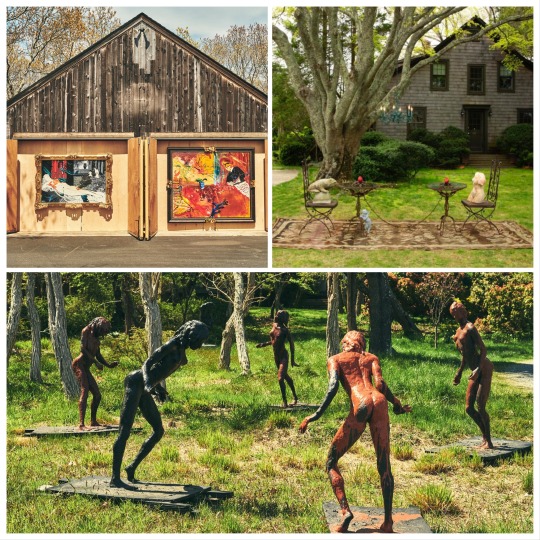
Paintings by Darius Yektai; Diane Blell’s “Table for Two Separate tables”; Erik Fischl’s “Young Dancers Dancing”
May 12, 2020
Daily Delights
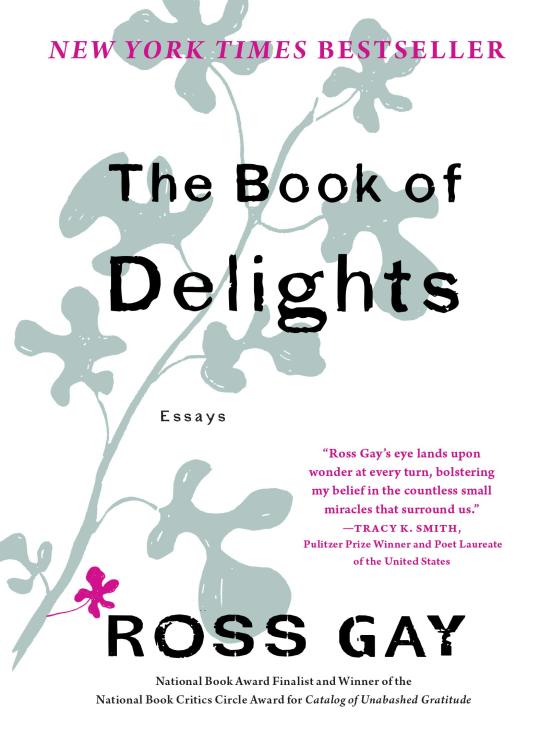
I have also been trying to hone my lens for finding a different kind of art in nature. With time to slow down and stay close to home, I have paid much closer attention to the little wonders that surround me. I began the practice of doing this shortly before self-isolation, when I learned about Ross Gay’s poetic essays collected in his book Daily Delights. https://www.amazon.ca/Book-Delights-Essays-Ross-Gay/dp/1616207922
As if prophetically, NPR featured him on my favorite podcast This American Life, in late January. https://www.thisamericanlife.org/692/the-show-of-delights
And this reminder, to savor life’s small pleasures was exactly the armor I needed for this period. Since February, I’ve kept my own daily delights journal. And here are just a few snapshots that have made the cut since quarantine began.

Baby ducks, Hula hoops, Elderly couple park bench massage, Backyard swing
May 13, 2020
Radio Days
While so much has changed about my daily rhythms, of late, there are a few pillars that I’ve kept in place to give my life some necessary scaffolding, in order to maintain a sense of familiarity and grounding.
One of these is the ritual that my partner and I have had for years, of listening to This American Life every weekend. Ira Glass’s strangely pleasing-though-nasally drone has accompanied hundreds of our road trips to mountains, lakes and forests, as we’ve sought weekend adventure. But for now, living room listenting has had to suffice.
On May 4th, the show just happened to be honored with the first ever Pulitzer Prize for audio journalism. So, that’s a well-earned feather in a podcast’s cap. But, awards or not, their carefully curated slices of life never fail to amuse and inspire.
Interestingly, I think more and more people are turning to podcasts, perhaps as an antidote to screen fatigue, and also because it seems to align with the nostalgia for days past that is so alive right now. So, I wanted to suggest a few podcasts that might particularly resonate at the moment.
If it’s a longing for “other” that’s calling you, there is an incredible website called Radio Garden that lets you travel anywhere in the world, to sonically “drop-in” to whatever environment intrigues you (http://radio.garden/listen/alpha-boys-school-radio/ijKUlByg). For a real time sense of what moves people across the globe, you can experience the music, stories, and language of cultures from Antanarivo to Zagreb, with just a spin of their online globe and a simple click. Here, you can access literally thousands of radio stations. However, in my experience, their interface works best on a Chrome rather than Safari browser.
Early in quarantine, when I was in sorest need of a good laugh, This American Life put together an episode on fiascos that really helped bring levity at a time when we all began to feel our world fall apart. https://www.thisamericanlife.org/699/fiasco
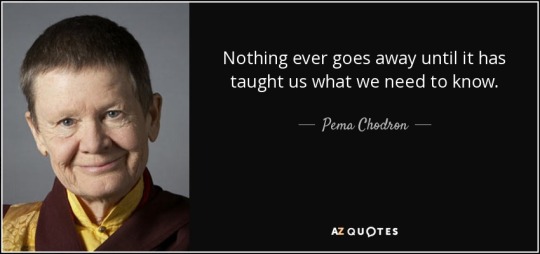
And speaking of when things fall apart, Buddhist nun Pema Chodron’s book of the same name has served as a sort of bible for many westerners, as they’ve turned to the ancient Tibetan tradition in which she was ordained. Another podcast favorite of mine is Krista Tippet’s On Being. And her most recent May 7thepisode featured herself and musician/meditator Devandra Banhart alternatively reading passages from this sage book, while reflecting on its relevance for the times.
https://onbeing.org/programs/devendra-banhart-when-things-fall-apart/
May 14. 2020
Finding Bliss

Ai Weiwei’s 2010 “Grapes”, with a coincidental resemblance to the coronavirus
Interviewed about how he’s responding to the virus, Ai Weiwei replied, “I never create anything. I just try to cope with the situation at hand.” We all need coping tools and strategies for those times when things fall apart. Ai Weiwei’s plainspoken answer sounds almost religious, the way he describes art as his salve. And this makes sense to me. But for many years, faith in an actual religion never did. Raised as a half-Catholic, half-Jewish Unitarian, I only attended services until I was about 11, when Sunday youth orchestra rehearsals took their place. So, I never fully understood the role of weekly church service until we travelled to India, for 10-days of Dalai Lama teachings. This annual offering, which he made for 30 years, was an even greater gift than we expected, given that these Kalichakra teachings ceased just after our 2007 trip, unbeknowst to us. Every day, for 5 hours, 1,000s of seekers flocked to the grounds of his Dharamsala temple, and listened by radio simulcast, in 1 of 17 native tongues, to his special blend of humor and clarity. Each day, we all left bubbling to the rim with reaffirmed intention to be our best selves. The coffeeshops, all over town, were a twitter with armchair philosophy between strangers trying to understand and integrate his words. Uncanny kindnesses abounded. And you could feel our resolve get ever more reinforced with each return to his daily talks. However, it’s only once we left Dharmasala, with equally grand intentions to “remember”, that I recognized the role of these daily infusions. Because with each passing day, best behaviors, careful speech, and pure thoughts deterioritated, if only a little at a time.

Note the curly-haired, golden-sweatered sore thumb in this sea of burgundy-robed monks...
So, while that did not instill in me a renewed church-going tradition, I have found my own ways to be “reminded.” They’ve just come in different forms.
For Geoff, it’s long runs and bike rides that serve as his spiritual medicine. And for me, it’s a panoply of things. Sometimes its communion with nature. Other times yoga. Writing. Handstand therapy. Or even what my favorite yoga teacher likes to call “Hammock Enlightenment.”
Eoin Finn is an artist of the highest order. Good living is his canvas. The body is his brush. And bliss is his paint. He calls his teaching Blissology, and spreads his backbends, heart-openers, and ocean loving vibes from Indonesia to Byron Bay.
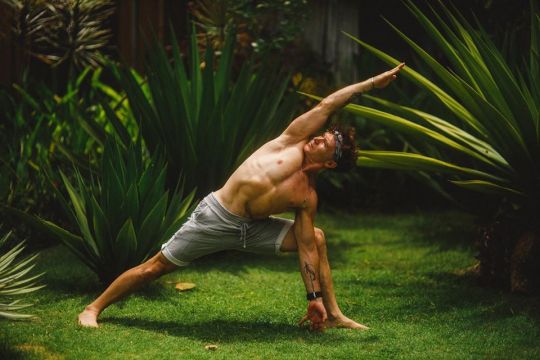
He and his family have been quarantining in Bali, since they were leading teacher trainings there, just before global travel nearly shut down. And fortunately, he continues to extend his generous spirit through free weekly livestream Stay Om yoga classes, on Facebook. If you happen to miss his 5 pm Sunday classes, the videos remain online to follow any time. So, I hope some of you take the opportunity to worship the DUDE (Delight in Universal Divine Energy) with him some time. I promise there will be plenty more acronymns and puns where that one came from. Plus, a good dose of deep stretches for your limbs and soul.
https://www.facebook.com/blissarmy/?__tn__=%2Cd%2CP-R&eid=ARD502BDBWegIvZPmn6ec9pFCtdEPtRnELt_iabxb0_c5Mmnzq3UPiAddV8fEanrbJLeSOhgYWdeQOlu
May 15. 2020
Birthday Bash
Those who know me are aware of the special challenges birthdays pose for my creativity. I relish the quest for the perfect homemade card, surprise gift, Bitmoji or GIF for a friend or family member. And I love throwing a good bash. I am also aware of the undue pressure this has caused my partner, over the years, to come up with a reciprocal gesture or party idea. But given the added constraints of a quarantine, Geoff went over and above the call of duty this year to produce!
While the novelty of Zoom parties had already worn off, he still managed to find a brilliant way for my loved ones to send serial video messages throughout the day, with the bonus of a clever twist. I’m not quite sure how he found the time, in his manic 70-hour work weeks, to put this together. But, 43 clues later, I was delivered a personalized crossword puzzle, with each hint related to the messenger. He really outdid himself this time, and I could not feel more grateful.
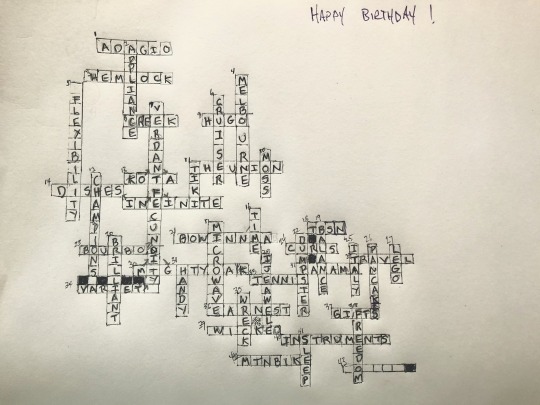
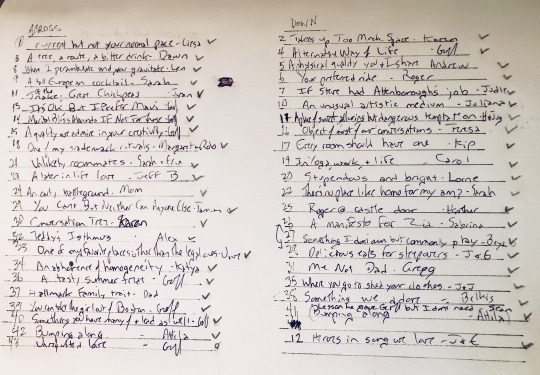
Meanwhile, unsure if he had anything up his sleeve, I got up to my own fun messying my hands to make this Covid Pinata. I confess, I borrowed the idea from an article I saw online, but just couldn’t resist.
And last night, of course with proper social distancing, we took great delight in beating the crap out of this brutal virus with a couple of friends.

0 notes
Photo

B:sides ~ weLLsh
The B:sides-Playlist 2017-10-30 @ Radio Vättervåg 98,5 Mhz
This week: weLLsh
1. 'B:zväng' TextMix & reading af MrZ Komposition & Produktion af SkåneJokke Lütz [0:41]
THE ULTIMATE GUIDE TO WELSH FOLK compiled by Cerys Matthews ~ albumrelease 27th October 2017 [ EUCD2744 ] ~ 2. Nansi Richards: Pwt ar y Bys (A Little Something for the Fingers) (trad., arr. Nansi Richards) From ‘Brenhines y Delyn/Queen of the Welsh Harp’ - Nansi Richards We kick off with a recording of the original Queen of the Harp, Nansi Richards, playing a traditional tune recorded in the twilight of her life. Nansi must have been some character. Like Jimi Hendrix, she played tricks with her instruments, playing harp with her back turned, or 2 at a time. Born in Oswestry in 1888, she went on to study at the Guildhall School of Music, London, and toured America. A huge figure in Welsh folk, she taught triple harp to Llio Rhydderch, as well as Dafydd and Gwyndaf from Ar Log, all of whom feature in this collection. ℗ 1959, Sain (Recordiau) Cyf licensed [2:15] 3. Robin Huw Bowen: Gypsy Waltzes (trad., arr. Robin Huw Bowen) From ‘Y Ffordd i Aberystwyth/The Road to Aberystwyth’ - Robin Huw Bowen Robin Huw Bowen is the world’s leading exponent of our national instrument, the triple harp. Interestingly, the tradition of playing this harp with three rows of strings and no pedals is alive and well today, only thanks to a family of Roma travellers led by Abram Wood, whose descendants would play harp for Queen Victoria. Enjoy the strength and muscularity of Robin on this track. He says, “Two wonderful Victorian swingers from the inimitable playing of Eldra Jarman. I had snatches of the first tune from Eldra while she was still alive, and then the second tune from a recording made of her by Professor Peter Crossley- Holland. Then I had the complete version of the first tune from an old BBC programme about Eldra… in St Ffagan’s Museum.” Robin is the only full-time professional Welsh harpist specializing solely in the Welsh triple harp, and his influence on the world of Welsh folk music and harping has been far-reaching. ℗ 2007, Sain (Recordiau) Cyf licensed [3:36] 4. Crasdant: Pibddawns Trefynwy (Monmouth Hornpipe) (trad., arr. Robin Huw Bowen/Andy McLauchlin/Stephen P. Rees/Huw Williams) From ‘Dwndwr/The Great Noise’ - Crasdant The harp reigns supreme in Welsh folk music, so here’s another, and again with Robin but joined this time by Stephen Rees, Andy McLauchlin, and the whistles and the stepping sound of clog dancer Huw Williams as Crasdant. For me this is the Welsh folk tune where one might regress to being a child, dressed head to toe in scratchy Welsh flannel learning folk dance steps. ℗ 2005, Sain (Recordiau) Cyf licensed to ARC Music Productions International Ltd. Published by Cyhoeddiadau Sain [3:53] 5. Phil Tanner: The Gower Reel (trad.) From ‘The Gower Nightingale’ – Phil Tanner Phil Tanner is one South Glamorgan’s greatest traditional folk singers. He was originally from Llangenith in the Gower Peninsula, South Wales, where he had sung all his life, however he wasn’t recorded until he was in his seventies. He became renowned locally as “the Gower Nightingale” and recorded for the likes of Columbia and the BBC. He passed away in February 1950 and was remembered in a BBC Radio 4 tribute by Wynford Vaughan-Thomas who referred to him as, “the voice of the sanest, happiest, kindest eccentric I ever knew”. ℗ 2003, Veteran Tapes licensed to ARC Music Productions International Ltd. Published by Veteran Tapes www.veteran.co.uk [3:35] 6. Calan: Rhif Wyth (Rhif 8 - No. 8) (trad., arr. Calan) From ‘Bling’ – Calan Calan bring together the remarkable talents of 5 young musicians giving a fresh and vibrant sound to traditional Welsh music. With a contemporary and lively approach, they breathe new life into the old traditions through their sparkling melodies, foot tapping tunes and spirited and energetic performances of Welsh step dancing. ℗ 2008, Sain (Recordiau) Cyf licens [2:44] 7. Cayo Evans: Men of Harlech (trad., arr. Cayo Evans) From ‘Marching Songs of The Free Wales Army’ – Cayo Evans Cayo was conscripted into the British Army aged 18, and served actively in Malaya. This experience, coupled with his fascination with politics, inspired by a Polish man who taught him at Millfield, embittered him towards the British Government and their manhandling of Wales. He was said to be radicalised after the drowning of a Welsh village to build Tryweryn reservoir (see Meic Stevens’ bio – CD1, track 2) and formed the Free Wales Army, whose dalliances with explosives and other public order offenses ended up with him serving a 13-month prison sentence. This track of the very famous marching song Men of Harlech has Cayo introducing then playing the accordion, and was released in 2008 on Anhrefn Records, Anhrefn being one of the pioneering bands singing Welsh language music across Europe in the punk era. ℗ 2008, Anhrefn Records licensed to [1:36] 8. Cowbois Rhos Botwnnog: Didl-Dei (Aled Wyn Hughes/Iwan Glyn Hughes/Dafydd Rhys Hughes, arr. Cowbois Rhos Botwnnog) ‘Didl-Dei’ appears on Cowbois Rhos Botwnnog’s album ‘Dawn y Trychfilod’ on the Sbrigyn Ymborth label. www.sbrigynymborth.com Cowbois Rhos Botwnnog are a folk band consisting of three brothers, Aled, Dafydd, and Iwan Hughes from Rhos Botwnnog, the Llyn Peninsula, and accompanying musicians and singers. They experiment with country, folk and rock music. Most of their lyrics are in Welsh. This example is a tiny but wonderfully whimsical interlude from this band worth checking out live and on record. ℗ 2007, Cyhoeddiadau Sbrigyn Ymborth licensed to ARC Music Productions International Ltd. Published by Cyhoeddiadau Sbrigyn Ymborth [0:26] 9. Cass Meurig and Nial Cain: Tair Meillionen (trad., arr. Cass Meurig/Nial Cain) From ‘Deuawd’ – Cass Meurig and Nial Cain Cass plays the fiddle and crwth, that medieval bowed lyre with gut strings and droney sound. She grew up in the north of England playing tunes and singing with her parents and sisters. Over the last few years she has played internationally and recorded with Welsh bands Pigyn Clust and Fernhill. Here she plays alongside Nial Cain, on guitar, who grew up in Deiniolen, in the slate quarrying heartland of North Wales. With a rich history of playing with folk and ceilidh bands, he played in many of Tyneside’s barn dance bands including the Borderers where he was taught fiddle by leader Forster Charlton, a living link to the pre-folk revival tradition. Ten years ago he moved back to North Wales and found his interest in the Welsh folk music tradition rekindled. ℗ 2008, Fflach Cyfyngedig licensed to ARC Music Productions International Ltd. Published by Cyhoeddiadau Mwldan Publications [2:43] 10. Llio Rhydderch: Dafydd y Garreg Wen (David of the White Rock) (trad., arr. Llio Rhydderch) From ‘Melangell’ – Llio Rhydderch Another intuitive musician who can make me burst into tears, such is the poignancy of her playing. Here Llio plays Dafyd y Garreg Wen, first published in 1784 by Edward Jones, the king’s harpist. Edward was the first to claim that the Dafydd in the title was a Caernarvonshire harpist who wrote the tune on his death bed (although there are some whispers that allude to a Scottish or even Russian origin. We��ll never know!). Llio Rhydderch is a traditional Welsh harper, a creative artist who is recognised as a most innovative and influential exponent of the Welsh triple garp. Llio is descended from the ancient Welsh harpers in an unbroken direct line which extends back many centuries. Through her, this unique line lives on and she is pivotal in its preservation as she passes on this ancient art to the next generation, teaching them to play traditional airs by ear, to be able to write variations before returning to the original melody. ℗ 2001, Fflach Cyfyngedig licensed to ARC Music Productions International Ltd. Published by Cyhoeddiadau Mwldan Publications [2:20] 11. Catrin Finch and Seckou Keita: Ceffylau (Horses) (Catrin Finch/Seckou Keita) From ‘Clychau Dibon’ – Catrin Finch and Seckou Keita (A Theatr Mwldan/Astar Artes co-production) Catrin is a fearless and natural performer and rare in that she is totally at home across genres: classical, jazz, folk and world music. Catrin has won accolades the world over for her virtuosic performances with some of the world’s finest orchestras. She has also worked with Malian kora player Toumani Diabaté, and Colombian band Cimarrón, and switches from Bach’s Goldberg Variations to traditional folk or Colombian joropo music with ease and aplomb. Seckou Keita, from the Casamance area of Senegal, was born into the world-famous royal Keita and griot Cissokho families, and has played with his uncle Solo Cissokho and Guinean master djembe player Mamady Keita, in addition to appearing with both Salif Keita and Youssou N’Dour, and more recently alongside Paul Weller, Damon Albarn and Julia Holter on the Africa Express presents The Orchestra of Syrian Musicians tour. I love how these two great players share with us their joy in bringing their far-off traditions together in such a beautiful collision. ℗ 2013, Catrin Finch/Seckou Keita/Theatr Mwldan/Astar Artes licensed to ARC Music Productions International Ltd. Published by Catrin Finch & Seckou Keita [5:17] 12. Elinor Bennett: Pant Corlan yr Ŵyn (trad., arr. Elinor Bennett) From ‘Y Delyn Gymreig/The Welsh Harp’ – Elinor Bennett Elinor Bennett is one of Wales’ most distinguished musicians, and has travelled extensively giving concerts, recitals and masterclasses. She is regarded as one of Britain’s most influential harp teachers, who, by the by, also taught Catrin the harp. Eagle eared listeners might also recognise her playing, as she was the harpist who played with us on Bulimic Beats on Catatonia’s Equally Cursed and Blessed. This is another firm favourite on the Welsh folk dance floor, a useful tune to wave those handkerchiefs to thank your adoring audience as you make the final circle and leave the stage. ℗ 1985, Sain (Recordiau) Cyf licensed to ARC Music Productions International Ltd. Published by Cyhoeddiadau Sain [2:33] 13. DnA (Delyth and Angharad Jenkins): Glyn Tawe (trad., arr. Delyth and Angharad Jenkins) From ‘Adnabod’ – DnA - Delyth and Angharad Jenkins Traditional and new Welsh music on the harp and fiddle. DnA by name, DnA by nature: music is in the very DNA of this hugely talented mother-and-daughter duo from Wales, both of whom enjoy international reputations not only as soloists but as members of such bands as Calan, Adran D, Aberjaber and Cromlech. Whether they’re vamping up a traditional oldie or minting something entirely new, there’s a timeless beauty to these intimate and irresistible conversations between harp and fiddle. ℗ 2013, Fflach Cyfyngedig licensed to ARC Music Productions International Ltd. Published by Cyhoeddiadau Mwldan Publications [4:22] 14. Jamie Smith’s MABON: Croeso Ioan (Jamie Smith, arr. Jamie Smith’s MABON) From ‘The Space Between’ – Jamie Smith’s MABON Jamie Smith’s MABON is an InterCeltic band; composer-accordionist Jamie was taken every year by his folk-dancing parents to the mighty Festival Interceltique in Brittany, surrounding him from an early age with music from the Celtic regions and beyond. He accompanied Welsh dancers at just five years old. Joining him here are Oli, a Welsh fiddler with Balkan flair; Paul, a guitarist from Wales who’s more Manx than plenty of people born on the Isle of Man; Matt, a bluegrassloving bass player from Carmarthen; and Iolo, a drummer from the Welsh woods with a passion for world music and jazz. They’ve played WOMAD, WOMEX, Shetland, Rainforest World Music Festival (Borneo), Fairport’s Cropredy Convention, Hebcelt, Celtic Connections, and the massive Festival Interceltique de Lorient. ℗ 2015, Easy on the Records licensed to ARC Music Productions International Ltd. Published by James Joughin AKA Jamie Smith [3:14]
15. 'Rome' from In The Midst Of Chaos There Is Stillness-CDn af Fleur de Lis [5:08] 16. 'In The Well' from Conquer Me-CDn af Namur [2:46] 17. 'In The Street' from Night Drops af Indian Wells [3:36] 18. 'All Was Well' from Live at Victoriateatern af Wintergatan [4:27] 1 jingle incl tune from Kmag #107 af Loopmasters Samples & 2 jingles from B:sides on Spotify DAGENS SYNAXARIUM This weeks BibleVers: "For your ways are in full view of the Lord, and he examines all your paths. The evil deeds of the wicked ensnare them; the cords of their sins hold them fast. For lack of discipline they will die, led astray by their own great folly." ~ Proverbs 5:21-23 Drink Espresso - God bless U! /MrZ :)
www.ib2.se Soli Deo Gloria
All Pix: MrZ ~ Wättern.se
Join Generation XYZ @ gen.xyz
Z
#B:sides#DIY#Music#Radio#Pod#PodCast#Lennarrrt#ib2#ib2se#MrZ#xyz#synaxarium#ARC#Wales#THE ULTIMATE GUIDE TO WELSH FOLK#Folk#Welsh#Fleur de Lis#Namur#Indian Wells#Wintergatan#PlayList#MixCloud
2 notes
·
View notes
Text
More of the Backyard Squad
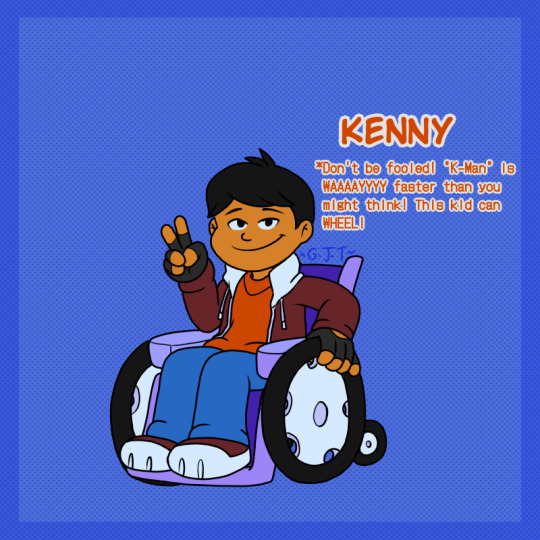
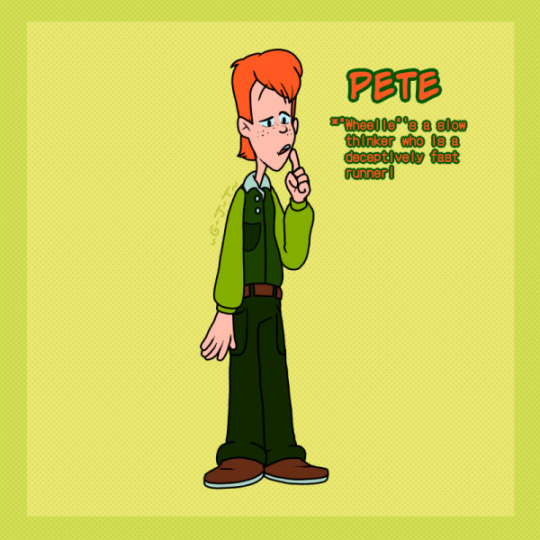
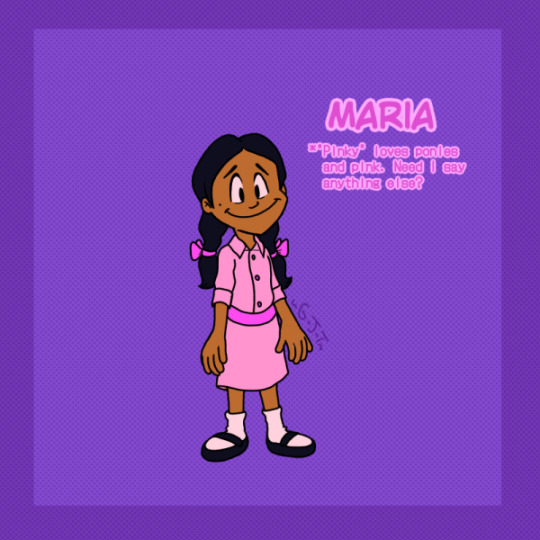
#backyard sports#backyard baseball#backyard sports 2007/2010 but better /hj#kenny kawaguchi#pete wheeler#maria luna#greenjunipertree's shitty doodles#bys au
13 notes
·
View notes
Photo

#BlackMusicMonthProfile (Day 4):John P. Kee (born John Prince Kee on June 4, 1962) is an American gospel singer and pastor. In the mid-1980s, Kee formed a community choir in Charlotte known as the New Life Community Choir or "NLCC." Over time the choir grew in popularity and has continued to travel throughout the area. The choir also includes Kee's own children.In 1990, Kee founded the Victory in Praise Music and Arts Seminar Mass Choir, or "V.I.P." in order to fellowship with various ministries, songwriters, musicians and choir directors from all over the country.Kee has been active for more than 20 years in the music field. He is primarily known for mixing traditional gospel with modern contemporary gospel and for having a soulful husky voice. In 2007, Kee was inducted into the Christian Music Hall of Fame.Kee is also known as "The Prince of Gospel Music". Kee says that it was during a trip to Michigan with his choir that he received a calling from God to be a preacher. Kee was in his mid-twenties when he became an ordained minister. In 1995, while ministering in Ohio, he received a prophetic vision and went forward with the building of a Fellowship Center in Charlotte. #happybirthdayjohnpkee @john.p.kee https://www.instagram.com/p/ByS-NHoBddN7pr5yblZOBpFX3D-7woJa17RrKI0/?igshid=yvr9b9gti1b5
0 notes
Text
Rozhovor s Miroslavem Nelibou
Máme skvělý tým, kde pracuje mnoho inspirativních lidí. Bez nich bychom nebyli tam, kde jsme. Proto bychom vám rádi naše kolegy představili v sérii rozhovorů. Prvním z nich je náš šikovný asistent Miroslav Neliba.
Jak dlouho v GS pracuješ?
Od listopadu 2007, je to tedy téměř 11 let.
Na jakou pozici jsi nastoupil/a (a jak se tvoje pracovní náplň v průběhu měnila)?
Nastupoval jsem jako “Operátor počítače pro vkládání dat”. Bylo to mé první zaměstnání, tak jsem se učil vše tak nějak za pochodu. Postupně jsem zjistil, že umím být pracovně poměrně dost univerzální a tak se jsem povýšil na “Asistenta”. Kromě běžných úkolů mám zpravidla na starosti i různé nahodilé situace, které je potřeba operativně řešit.
Jak jsi vlastně ke GS přišel? Našli si oni tebe nebo ty je?
Byla to naprostá náhoda, po pár měsících, když jsem si dostatečně užil volno po maturitě, jsem vzal na ÚP první příležitost a s myšlenkou, že cokoliv je lepší než 0,- jsem se pustil do práce.
V čem je podle tebe práce v GS pro tebe osobně přínosná?
Jsem v kolektivu, kde se prostě cítím dobře, lidi okolo mě zajímá můj názor, ale taky mi bez obalu řeknou ten svůj. Nebojím se říct cokoliv komukoliv. V neposlední řadě jsem samostatný a finančně nezávislý.
Co bys o GS řekl/a případným zájemcům?
To se musí vidět a vyzkoušet.
V čem se GS odlišuje od jiných zaměstnavatelů?
Smysluplná práce pro hendikepované skutečně není jen líbivý slogan. Je to příležitost pracovat na projektech, které mají termíny, kde je vyžadována vysoká kvalita práce a za které zákazník rád platí. GS umí vytvořit svým zaměstnancům takové podmínky pro práci, aby byli schopni své hendikepy “obejít”, dostat ze sebe to nejlepší a nevystavovat se zbytečnému stresu.
Představoval/a sis, že budeš jednou pracovat na takovém místě nebo jsi měl/a jiné představy o své pracovní kariéře?
Kariéra mě nezajímá. Jde mi především o lidi, kteří se mnou pracují a o rozumné množství peněz za odvedenou práci.
Jaké jsou tvoje koníčky/čím trávíš volný čas?
Sbírání a hraní videoher
Četba fantasy, beletrie a odborné literatury (psychologie, filozofie, historie, sociologie)
Příležitostně cestování.
Jaký je tvůj názor na současné zaměstnávání hendikepovaných ve firmách? Myslíš, že to je uspokojivé nebo by se mělo něco změnit?
Z osobní zkušenosti mých přátel oproti minulosti naprostá pohoda, kdo chce pracovat, může. Občas mi dokonce přijde, že zdravý člověk má paradoxně horší startovací pozici než hendikepovaný.

0 notes
Text

such as La Goulue and Jane Avril, were highly paid for their appearances at the Moulin Rouge and elsewhere. The female dancers of the French Second Empire and the fin de siecle developed the various cancan moves. The Galop from Jacques Offenbach's Orpheus in the Underworld is the tune most often played with the can-can (a somewhat simplified form and a more evolved one Can-Can (Orpheus in the Underworld). Performed on the accordion
Archived 2007-01-11 at the Wayback Machine).
The can-can was adapted as an American movie titled "Can Can"(1960), acted by Frank Sinatra and Shirley MacLaine with music by Cole Porter. Orpheus is a hero in Greek mythology.
When he played his lyre the world would sway to the music. It was noted he could charm mortals, Gods and even stones with his music. He was the son of a Muse. He was a companion of Jason and the Argonauts.
Orpheus was married to a dryad named
Eurydice. In one version of the myth, while trying to get away from a satyr Eurydice was bitten by a snake and went to Hades. Orpheus rode the ferry across the river Styx to bring her back from the underworld. He played his lyre to make Cerberus fall asleep, and moved the wife of Hades, Persephone, with his music. She said he could take Eurydice back to the upper world if he didn't look back at Eurydice until they both got back up to the land of mortals. Racked bys AND
1 note
·
View note
Text
June Song 18: "From Paris With Love" by Melody Gardot
"In times of great difficulty, art will always break through. Created in isolation, made with love, this project is a reflection of the strength of the human spirit. My most heartfelt thanks to the vast array of musicians and people currently confined all around the world, who made this project possible. Together with Decca Records, all proceeds from the royalties of this song have been donated to a COVID charity organization to help healthcare workers during this time of unprecedented crisis." -- Melody Gardot
“From Paris With Love” by Melody Gardot
“From Paris With Love” is a gorgeous new charitable track from American Jazz singer Melody Gardot. It’s exactly the kind of healing song we need right now with a message of unity, love and an appreciation for the simpler things. Gardot, like so many others, has been forced to put the recording of her newest studio album on hold, during the global pandemic. However, she was inspired to do something to help other artists who are in the same position. To complete ‘From Paris With Love’, Gardot hired a remote orchestra of string and wind musicians and then asked fans around the world to submit a “5-second video portrait” holding up a sign with the message “From (wherever you are) with love”. More of this please.
“From Paris With Love”
Lovers tucked into a quiet cafe Sat beneath a shade of red They fall in love like falling out of bed Half a silhouette of passer-bys Half a glass within my hand Drink to life as if there is no end Maybe one day I will see you Maybe one day I will see you soon With love, my love A kiss beneath the moon River waking to the morning light Lazy boats around the bend Shimmers once or twice to move this pen Beauty fades before the mirrors when Beauty knocks upon your door Life is leading us to something more Maybe one day I will see you Maybe one day I will see you soon With love, my love A kiss beneath the moon Maybe one day I will see you Maybe one day I will see you soon With love, my love A kiss beneath the moon With love, my love A kiss beneath the moon Lovers tucked into a quiet cafe Sat beneath a shade of red They fall in love like falling out of bed
-xxx-
MELODY GARDOT SPOTIFY BIO The story of vocalist, guitarist, and pianist Melody Gardot is remarkable; she's persevered against abject adversity throughout her life. Blessed with a beautiful alto voice and grand insight as a songwriter, Gardot overcame a life-threatening bicycle accident early in her career. As amazing as her story is, what is more evident is that she possesses a blue, jazz-oriented style and dusky persona that reflect not only her afflictions, but conversely the hope and joy of making personalized music that marks her as an original.
Born in New Jersey in 1985, she took up piano and played as a youngster on the nightclub scene of Philadelphia, influenced by jazz, folk, rock, and pop music. At age 19 she was a fashion student at the Community College of Philadelphia. But, on a fateful day, while riding her bicycle, the driver of a Jeep made an illegal turn, hurtling into Gardot and leaving her in the street for dead. As she lay hospitalized for months with multiple head injuries and pelvic fractures, her love for music was the best therapy she could receive. While in her hospital bed, she wrote and recorded songs that would become the EP Some Lessons.
Upon her eventual release from intensive care, Gardot found the strength and determination to further her career. Hypersensitive to light and noise, she wore dark glasses. On-stage she also required a special seating unit, and often wore a Transcutaneous Electro-Nerve Stimulator, a TENS device, to assist in alleviating her neuralgic muscle pain. Despite these hurdles, she recorded her debut full-length, Worrisome Heart, which was reissued in 2007 by the Verve label. Well-received, the album drew comparisons to Laura Nyro, Joni Mitchell, and Eva Cassidy.
In 2009, working with producer Larry Klein and arranger Vince Mendoza -- both known for their work with Joni Mitchell -- Gardot followed up her Verve debut with My One and Only Thrill. The album peaked at number two on the Billboard U.S. Jazz Albums chart. She returned in 2012 with her third studio album, The Absence, featuring production from guitarist/composer Heitor Pereira. The effort continued her upward trajectory, landing in the Top 30 on the Billboard 200 and reaching the top of the U.S. Jazz Albums chart.
Gardot altered her musical direction when she returned to the recording studio. She reteamed with Klein and focused on music strongly influenced by R&B, blues, and jazz in a set of original, socially conscious songs. Her first single/video, "Preacherman," was inspired by the death of Emmett Till. The second, "It Gonna Come," was released as a docu-video a week prior to the album. The full-length Currency of Man was released by Decca in June of 2015. In 2018, she delivered her first full-length concert album, Live in Europe. Recorded at a series of shows between 2012 and 2016, the album showcased Gardot backed by her adept touring ensemble. ~ Michael G. Nastos, Rovi
Ventipop June 2020 Playlist
0 notes
Text
Během rozhovoru s druhým člověkem se vzájemně díváme do tváře. Mezi nejvýraznější části obličeje patří nos, jehož vzhled výrazně ovlivňuje naše sebevědomí. Jen málokterá operace může tak pozitivně změnit život jako zdařile provedená operace kosmetické vady nosu. Tak velký dopad nemá žádná jiná operace v estetické chirurgii. O tom se přesvědčíme v nové knize z pera známého plastického chirurga, doc. MUDr. Jana Měšťáka, CSc., který působí na klinice Esthé a v Nemocnici Na Bulovce. Monografie nese název Estetické operace nosu v klinické praxi.
Kniha byla pokřtěna v prostorách bistra Nekázanka 11 na Praze 1. Křtu se zúčastnili blízcí přátelé autora, z nichž se někteří stali zároveň kmotry knihy, a to Marek Eben, Kateřina Sokolová a Helena Vondráčková. Jaroslav Svěcený zahr��l skladbu Metamorfózy lásky, složenou speciálně pro Jana Měšťáka k této příležitosti. Jan Měšťák měl z podpory svých přátel radost. „Přítele poznáš tak, že ho vidíš jednou za dva roky a jako bys ho viděl včera. A to na rozdíl od jiných, které vidíš včera a dnes už neznáš ani jeho jméno,“ řekl docent. Kromě zmíněných jej přišli podpořit lékařští kolegové Libor Kment, Karel Urban a Veronika Hromádková z kliniky Esthé a také hudební skladatel, profesor Vadim Petrov.
kolegové lékaři L. Kment. V. Hromádková, J. Mě ák a K. Urban
kolegové lékaři L. Kment. V. Hromádková, J. Mě ák a K. Urban
Marek Eben se zamýšlel nad tím, proč si ho Jan Měšťák vybral mezi kmotry knížky. „Došlo mi, že Honza potřebuje člověka, který je nestranný. Když se někdo podívá na mě, tak hned ví, že jsem nestranný, protože na můj obličej Jan Měšťák určitě nevztáhl ruku. Natož na můj nos. Je to zvláštní, že lidé jsou tak strašně hákliví na svůj nos, přestože to je něco, co nikdy nevidí. Ono to fakt nejde, vidět si na špičku nosu! A když si to zkusíte a vidíte ji, je to důvod navštívit Honzu,“ řekl Marek Eben.
M. Eben obdivuje housle z roku
prof. Vadim Petrov pozoruje M. Ebena
Autor na knize pracoval více než dva roky a je to jeho již druhá kniha o nosech. „Nová monografie je obohacena o řadu kapitol, které v původní knize nebyly uvedeny, včetně výzkumné části. Ale především to jsou mnohdy až dojemná autentická sdělení všech potenciálních pacientů před operací a po operaci, která v celém spektru operací estetické chirurgie nemají obdobu,“ sdělil Jan Měšťák, který za svou lékařskou kariéru odoperoval okolo 4 000 nosů. Kniha je bohatě obrazově dokumentovaná, obsahuje téměř 100 barevných fotografií a kreseb. Čtenář tu najde stručnou historii, anatomii a vývoj chirurgického řešení korektivních operací nosu. Jsou zmíněny možné komplikace i doporučení vhodného postupu, včetně výběru operatéra a pracoviště.
Pro zúčastněné přátele Jana Měšťáka je velká čest, být kmotry jeho nové knihy. „S Honzou Měšťákem jsem se poznala v roce 2007, když jsem soutěžila na Miss ČR. Honza byl tehdy v porotě a vždy mi moc fandil a podporoval mě, čehož si moc vážím. Je to bezpochyby kapacita ve svém oboru, ale kromě toho i velmi hodný člověk se srdcem na správném místě,“ řekla Kateřina Sokolová, Miss ČR 2007.
dcera Terezka a Katka Sokolová
zasněná K. Sokolová
I Helena Vondráčková se s Janem Měšťákem zná velmi dlouho a řadí ho mezi své nejbližší a nejvěrnější přátele. „Honzy si vážím nejen jako vynikajícího plastického chirurga, ale i jako skvělého, noblesního a citlivého člověka. Má obrovské charizma a u svých pacientů vzbuzuje naprostou důvěru a jistotu,“ pochvaluje si kamaráda Helena.
J. Měšťák s H. Vondráčkovou
gentleman
Známý chirurg věří, že každá operace v plastické chirurgii přináší dobrý pocit, pokud je úspěšně provedená. „Operace nosu považuji za nejzodpovědnější operaci, protože rozhoduje o osudu operovaného. Pokud není dobře provedená, přináší duševní strádání jako žádná jiná operace v plastické chirurgii, někdy dokonce až se sebevražednými úmysly. Pokud je však úspěšná, neexistuje žádná jiná operace v estetické chirurgii, která by přinesla tolik osobního štěstí. Současně je nejobtížnější operací, protože nikdy předem nevíte, s jakými složitostmi uvnitř nosu se setkáte,“ upřesnil Jan Měšťák.
Ten se více než 40 let věnuje oboru plastické chirurgie a mění životy mnoha lidem. „Plastická chirurgie je velmi široký obor, kde estetická chirurgie tvoří jen nepatrnou jeho část. Jsou to vrozené a získané vady, úrazy, poúrazové stavy, kožní nádory, rekonstrukční chirurgie, popáleniny aj. Každá z těchto problematik má svoje osobní kouzlo,“ vyjmenoval odborník.
Foto: archiv kliniky Esthé
Křest knihy Estetické operace nosu v klinické praxi. Během rozhovoru s druhým člověkem se vzájemně díváme do tváře. Mezi nejvýraznější části obličeje patří nos, jehož vzhled výrazně ovlivňuje naše sebevědomí.
0 notes